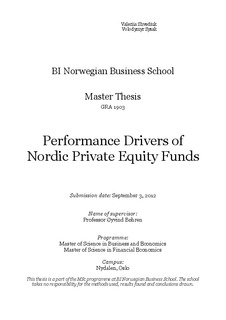Performance drivers of nordic private equity funds
Master thesis
Permanent lenke
http://hdl.handle.net/11250/94821Utgivelsesdato
2013-02-18Metadata
Vis full innførselSamlinger
- Master of Science [1621]
Sammendrag
In his paper we investigate the performance determinants of Nordic private equity funds. In this study we look at the industry at the fund level as opposed to the portfolio company level. To proxy for performance, we use both the Internal Rate of Return (IRR) and Total Value to Paid-In capital ratio (TVPI) as the dependent variable in our model, both of which are the standard metrics of performance in the private equity industry. Having reviewed the relevant literature, we define three groups of factors, or independent variables: the Fund characteristics (size, vesting period, stage, geographical and industrial specialization), General Partner characteristics (sequence of the fund), and Principal-Agent Relationship characteristics (managerial fee, carry profit, simultaneous management). Using the proprietary data provided by an investment firm specializing in the Nordic secondary private equity market, we have examined 52 private equity funds with operations in the Nordic region. Factors such as size, vesting period, geographical specialization, sequence, managerial fee and simultaneous management are found to have a significant impact on the fund performance. According to our results, the Nordic funds that are likely to deliver high returns, exhibit the following characteristics: size less than excessively large, vesting period shorter than average, relatively broad geographical focus, being among the funds first raised by a given private equity firm, low managerial fee, and, finally, being managed simultaneously with other funds. The robustness tests performed indicate stability of the signs of the coefficients. Furthermore, these tests uncover an interesting interaction between the sequence of the fund and the simultaneous management variables, possibly as a result of the private equity fund manager skill accumulation process. The findings set the ground for further studies, such as closer examination of the causality between the fund performance and fund characteristics, interaction between the independent variables, or comparison of Nordic private equity fund performance versus those of other regions.
Beskrivelse
Masteroppgave(MSc) in Master of Science in Business and Economics - Handelshøyskolen BI, 2013
